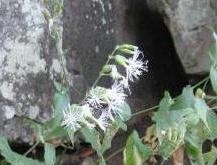Blue Ridge catchfly
(Silene ovata)

Description
Silene ovata, the Blue Ridge catchfly or ovate-leaved catchfly, is a herbaceous plant in the family Caryophyllaceae. This perennial plant grows up to 1.5 m tall and has large opposite leaves without petioles which are 5–12 cm long and taper to a long point, 2–5 cm wide and numerous finely fringed white flowers with a tube. A flora of Kentucky lists the species as occurring in "dry to mesic forests" while the flora of North Carolina lists the habitat as "rich woods." While unknown in Florida, it occurs in most of the southeastern United States from Georgia, eight widely scattered Alabama counties, to Mississippi and Arkansas (where it occurs only in eight counties in the Ozark region), north into southern Illinois and Indiana, Kentucky, and Virginia. The plants have a limited distribution range wide as indicated by their global G3 status. Jones lists the blooming season as from June to September. Silene ovata is listed as G3 on the NatureServe conservation status, meaning it is vulnerable and globally rare. Typically G3 species have 21 to 100 occurrences globally, or have 3,000 to 10,000 individuals globally. Silene is a genus of flowering plants in the family Caryophyllaceae. Containing nearly 900 species, it is the largest genus in the family. Common names include campion and catchfly. Many Silene species are widely distributed, particularly in the northern hemisphere. Members of this genus have been the subject of research by preeminent plant ecologists, evolutionary biologists, and geneticists, including Charles Darwin, Gregor Mendel, Carl Correns, Herbert G. Baker, and Janis Antonovics. Many Silene species continue to be widely used to study systems, particularly in the fields of ecology and evolutionary biology. The genus has been used as a model for understanding the genetics of sex determination for over a century. Silene species commonly contain a mixture of hermaphroditic and female (or male-sterile) individuals (gynodioecy), and early studies by Correns showed that male sterility could be maternally inherited, an example of what is now known as cytoplasmic male sterility. Two independent groups of species in Silene have evolved separate male and female sexes (dioecy) with chromosomal sex determination that is analogous to the system found in humans and other mammals. Silene flowers are frequently visited by flies, such as Rhingia campestris.
Taxonomic tree:







